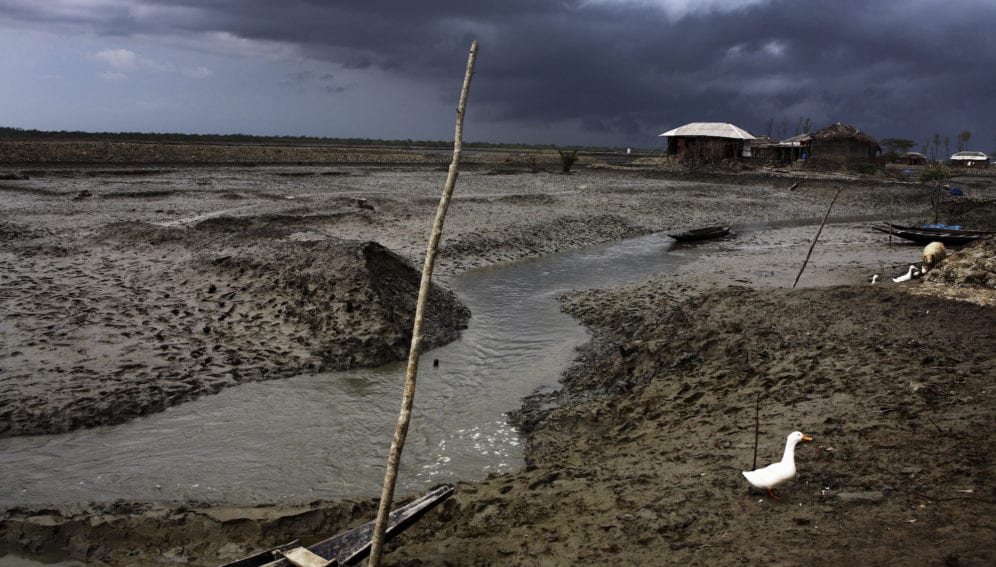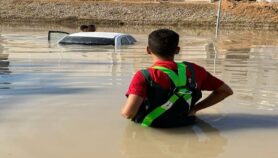Send to a friend
The details you provide on this page will not be used to send unsolicited email, and will not be sold to a 3rd party. See privacy policy.
ICTs can help disaster response, so long as they are fully integrated into overall systems, says Nalaka Gunawardene.
When hazards turn into disasters, they challenge even the best prepared societies: history is awash with examples, from the impact of the Japanese earthquake and tsunami in 2011, to Hurricane Katrina in New Orleans. But countries lacking robust disaster management plans can easily become overwhelmed.
Tropical cyclone Roanu — which affected Bangladesh, India and Sri Lanka mid-May — highlighted strengths and weaknesses in how these countries cope with hydro-meteorological disasters. [1]
Although it was a relatively weak cyclone, Roanu still brought some of the highest rainfall levels experienced in recent years in southern India and Sri Lanka. It is another example of the extreme weather events associated with climate change.
Sri Lanka was the worst hit — and, as it turned out, also the least prepared to cope with the impacts.
Torrential rains caused the worst floods in over two decades in the densely populated Western Province, destroying or damaging over 5,000 homes and displacing more than 300,000 people. They also led to landslides in hilly areas that buried entire communities. In total, these events killed 104 people and another 99 were missing by May 26. [2]
According to official estimates, between 25,000 and 30,000 businesses were impacted, most of them small enterprises. In a preliminary assessment, the finance ministry placed the economic loss at around US$2 billion, equal to 1.6 per cent of total GDP. [3]
Deadly information blocks
While property damage from rising waters and collapsing hills is unavoidable, loss of lives can be minimised with early warnings and timely evacuations. And after disasters hit, better information sharing can improve the rescue and relief efforts. Technologies can help this endeavour, provided they are integrated into overall systems and anchored in good policies and practices.
There have been glaring gaps on both fronts in Sri Lanka. This has reignited the debate on improving disaster communications.
Post-disaster analyses have faulted government agencies for being ill-prepared and poorly coordinated. For example, survivors in landslide-affected villages have alleged that the authorities had “failed to issue any alerts or evacuation warnings”.
The onset of Roanu was known several days in advance, and the department of meteorology had cautioned about heavy rains and strong winds. However, location specific warnings were not issued, or did not reach those in immediate danger.
According to media reports, the government’s Disaster Management Centre (DMC) was using loudspeakers and megaphones to warn residents at risk from landslides. [4]
The question arises: why rely on one or two such basic methods? In Sri Lanka mobile phone subscriptions outnumber people (116 to every 100 persons), and practically every adult carries a mobile. But government agencies have not yet incorporated ICTs into their warning strategies.
All mobile subscribers in Sri Lanka receive unsolicited text messages (SMS) from their President at the new year and other special occasions. So why was this technology not used to warn people when adverse weather caused havoc, asked The Sunday Times newspaper. [5]
The Colombo-based ICT research organisation LIRNEasia has also been promoting the use of mobile broadcasting for disaster communications: mobile networks are used to deliver text messages simultaneously to multiple users in a specified area. [6]
That telecom companies are willing to play their part was demonstrated when the largest network allowed subscribers to donate money to flood relief through a simple SMS. But only government agencies can issue disaster warnings and evacuation orders — which they did belatedly and patchily in this instance.
As ICT researcher and activist Sanjana Hattotuwa wrote: “The DMC needs to urgently upgrade, or shut down. The untenable reliance on antiquated infrastructure and old thinking just adds to any disaster.” [7]
The tech is out there, so why not use it?
After the floods and landslides, Sri Lankan society responded with characteristic generosity to help those affected. Frustratingly, though, relief support did not reach some communities while others received too much.
These mismatches could have been avoided if the first responders had used Sahana, a locally designed software system for disaster information management, first developed by Lankan computer professionals in the aftermath of the 2004 Indian Ocean tsunami.
Sahana uses a set of interconnected databases that can be incorporated into a system to manage disaster relief efforts. For example, it can match relief supplies with locations that need them, or track missing persons and compare with those rescued yet separated from loved ones. [8]
“Trust is the oil that moves the wheels of law and order, as well as public safety, in the right direction.”
Nalaka Gunawardene
Since 2005, Sahana has evolved into a global free and open source software project supported by hundreds of volunteer contributors around the world. It has been used by relief agencies responding to sudden-onset disasters in locations as far apart as Haiti, Japan, Pakistan, the Philippines and the United States.
For unknown reasons, Sahana has not yet been accepted and implemented in Sri Lanka, says LIRNEasia’s chair Rohan Samarajiva, who was associated with its early development and promotion.
The disaster management ministry has acknowledged there were gaps in the official response, but its secretary says such lapses were “unavoidable during a disaster of this magnitude”.
Nevertheless, better management of disaster information is vital for all disaster risk reduction policies and strategies. For Sri Lanka’s current government, with its public commitment to enhancing governance, it is an imperative.
Disaster response must evolve
Another factor that came into sharp focus during Sri Lanka’s encounter with Roanu is the importance of public trust in effective early warning systems and post-disaster response.
Trust is the oil that moves the wheels of law and order, as well as public safety, in the right direction.
When people receive warnings but choose to ignore them, it is important to probe why. Is it that they have so many false alarms that they have lost faith in such systems? Do they lack trust in the government’s capacity to safeguard private property after evacuation?
In the Kelani River deltaic suburbs of Colombo city, many residents hesitated to evacuate homes as river levels kept rising. The prime minister assured them on television that armed forces and police would protect property, but that did not convince everyone.
According to Samarajiva, LIRNEasia’s research shows that people usually have good reasons for ignoring warnings and orders, “so if we want to design effective messages, we have to start from the minds of the recipients. We must practice empathy.” [9]
Complexity in modern societies is why technological and bureaucratic solutions must be accompanied by sociologically sound approaches.
Gone are the days when disaster managers had the last word. As more disaster-affected people use social media to directly express their needs and sentiments, disaster managers have another public platform in which to listen — and engage.
Nalaka Gunawardene is a Colombo-based science writer, blogger and development communication consultant. He co-edited ‘Communicating Disasters: An Asia Pacific Resource Book’ in 2007. He tweets from @NalakaG
This article was originally published on SciDev.Net’s South Asia edition.
References
[1] Cyclone Roanu finally runs out of steam (Al Jazeera, 22 May 2016)
[2] Sri Lanka: Floods and Landslides Situation Report No 2 (as of 26 May 2016). UN Office for the Coordination of Humanitarian Affairs (UNOCHA)
[3] Storm costs nation USD 2 billion (Sunday Observer, 22 May 2016)
[4] Floods and Landslides in Sri Lanka Leave Dozens Dead. (The New York Times, 18 May 2016)
[5] Solutions under our nose for better crisis co-ordination (The Sunday Times, 29 May 2016)
[6] Mobile messages could aid early warning in the Maldives (SciDev.Net 18 August 2009)
[7] Sanjana Hattotuwa Roanu’s wrath (Sunday Island, 29 May 2016)
[8] Sahana Software Foundation: History
[9] Rohan Samarajiva Disaster risk reduction, empathy and message design. (Daily FT, 21 May 2016)














